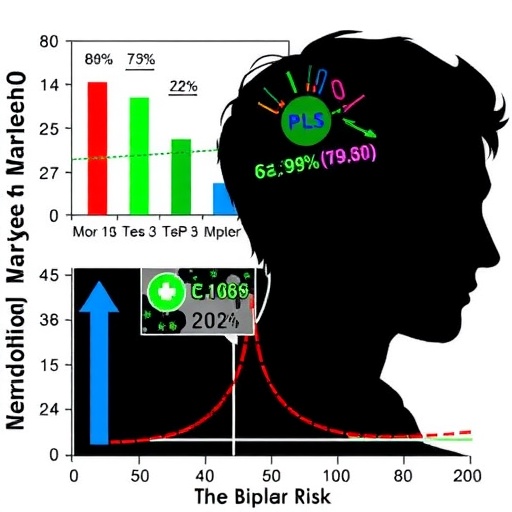In a groundbreaking study published in BMC Psychiatry, researchers have unveiled compelling neuroendocrine biomarkers that could revolutionize the way clinicians predict suicidal ideation among bipolar disorder patients during depressive episodes. Bipolar disorder (BD), characterized by its oscillation between manic and depressive phases, remains one of the most devastating psychiatric illnesses due to its strong association with increased suicide risk. Suicidal ideation (SI), often a harbinger of actual suicide attempts, presents a critical window for intervention, yet its biological underpinnings have remained elusive until now.
This innovative cross-sectional study harnessed the power of extensive clinical data combined with machine learning to dissect the intricate neuroendocrine landscape influencing SI in BD patients. Drawing from electronic medical records accumulated over nearly six years at The First Affiliated Hospital of Jinan University, located in Guangzhou, China, the research team meticulously analyzed data from 635 hospitalized individuals experiencing depressive episodes. Astonishingly, a significant 59.8% of these patients exhibited suicidal ideation, underscoring the urgency for better predictive tools.
Central to the study’s findings was the identification of free thyroxine (FT4) and testosterone as crucial neuroendocrine markers linked with SI risk. Lower serum levels of FT4, a principal thyroid hormone, were significantly correlated with heightened suicidal ideation. This discovery resonates with prior hypotheses regarding thyroid dysfunction’s role in mood regulation and suicidality but now anchors these effects in robust clinical data with clear statistical significance. Alongside FT4, diminished testosterone levels emerged as another potent predictor, expanding the focus beyond traditional psychiatric assessments.
Beyond neuroendocrine factors, patient clinical characteristics also played a decisive part. The research unveiled that an earlier age of bipolar disorder onset dramatically increased the likelihood of suicidal thoughts. This insight suggests that the developmental trajectory of BD impacts neuropsychological vulnerability to suicidality. Furthermore, the presence of psychotic symptoms during depressive episodes compounded this risk, highlighting the complex interplay between neuroendocrine dysregulation and behavioral manifestations in these patients.
To translate these findings into practical clinical applications, the researchers deployed a supervised machine learning model, specifically a Naive Bayes classifier, to pinpoint the most predictive variables for SI. Remarkably, the model spotlighted age of onset as the paramount factor, reinforcing the clinical narrative that early BD onset signifies more severe disease progression and associated suicidal tendencies. The model’s ability to integrate multifaceted data sources — clinical, hormonal, and symptomatic — showcases the future of precision psychiatry.
The implications for healthcare providers are profound. By incorporating routine measurement of FT4 and testosterone alongside detailed patient history, clinicians can achieve unprecedented sensitivity in identifying BD patients at greatest risk for suicide. Such stratification could empower targeted preventative interventions, personalized medication regimens, and more intensive psychosocial support, all geared toward mitigating this devastating outcome.
Moreover, this research epitomizes the emergent paradigm in psychiatry that leverages big data analytics and machine learning to elucidate complex mental health disorders. Traditionally, psychiatry has struggled with subjective diagnostic criteria and a paucity of objective biomarkers. Studies like this herald a new era where biological data and computational models converge to enhance diagnostic precision and therapeutic strategies.
Nevertheless, the study acknowledges its limitations, including its cross-sectional nature which precludes causal inferences, and its reliance on hospitalized patient data, potentially biasing the sample towards more severe cases. Future longitudinal studies are warranted to track neuroendocrine fluctuations over time and their temporal relationship with SI onset, which would further solidify these biomarkers’ predictive validity.
Another exciting avenue opened by this research is the exploration of hormonal modulation as a therapeutic intervention. If reduced FT4 and testosterone are causative in SI, therapies aimed at normalizing these hormones might reduce suicidal risk. Clinical trials investigating such strategies could pave new roads toward integrative treatments that combine psychopharmacology with endocrinology.
The geographic context of this study, conducted in China, also highlights the global relevance of neuroendocrine influences on BD. Cultural, environmental, and genetic factors intertwine with neurobiology to shape psychiatric presentations, and this research provides a vital data point from East Asia, enriching the worldwide psychiatric research mosaic.
In summary, this study breaks new ground by combining endocrinology, psychiatry, and machine learning to tackle the pressing issue of suicidal ideation in bipolar disorder. It offers hope that better understanding of neuroendocrine abnormalities will translate into earlier identification and more effective prevention of suicide, ultimately saving countless lives. As the scientific community builds upon these insights, the future of bipolar disorder management appears increasingly hopeful and technologically empowered.
Subject of Research: Neuroendocrine predictors of suicidal ideation in bipolar disorder patients during depressive episodes.
Article Title: Neuroendocrine abnormalities as predictors of suicidal ideation in bipolar disorder patients during depressive episodes: a cross-sectional study
Article References:
Fan, X., Shi, X., Deng, F. et al. Neuroendocrine abnormalities as predictors of suicidal ideation in bipolar disorder patients during depressive episodes: a cross-sectional study. BMC Psychiatry 25, 1029 (2025). https://doi.org/10.1186/s12888-025-07384-0
Image Credits: AI Generated




